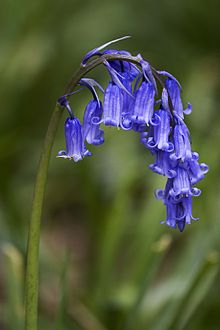Hyacinthoides non-scripta

Hyacinthoides non-scripta (formerly Endymion non-scriptus or Scilla non-scripta) is a bulbous perennial plant, found in Atlantic areas from north-western Spain to the British Isles, and also frequently used as a garden plant. It is known in English as the common bluebell or simply bluebell, a name which is used in Scotland to refer to the harebell, Campanula rotundifolia. In spring, H. non-scripta produces a nodding, one-sided inflorescence of 5–12 tubular, sweet-scented violet–blue flowers, with strongly recurved tepals, and 3–6 long, linear, basal leaves.
H. non-scripta is particularly associated with ancient woodland where it may dominate the understorey to produce carpets of violet–blue flowers in “bluebell woods”, but also occurs in more open habitats in western regions. It is protected under UK law, and in some other parts of its range. A related species, H. hispanica has also been introduced to the British Isles and hybridises with H. non-scripta to produce intermediates known as H. × massartiana.
Hyacinthoides non-scripta was first described by Carl Linnaeus in his seminal 1753 work Species Plantarum, as a species in the genus Hyacinthus.[2] The specific epithet non-scriptus[Note 1] means “unlettered” or “unmarked” and was intended to distinguish this plant from the classical hyacinth of Greek mythology. This mythical flower, which was almost certainly not the modern hyacinth,[3] sprang up from the blood of the dying prince Hyacinthus. His lover, the god Apollo, shed tears that marked the new flower’s petals with the letters “AIAI” (“alas”) as a sign of his grief.[4]
In 1803, Johann Centurius von Hoffmannsegg and Johann Heinrich Friedrich Link transferred the species to the genus Scilla, and in 1849 Christian August Friedrich Garcke transferred it to the genus Endymion (now a synonym of Hyacinthoides); it is still widely known as “Scilla non-scripta” or “Endymion non-scriptus”.[5] In 1934, Pierre Chouard transferred the species to its current placement in the genus Hyacinthoides.[6] Scilla was the original Greek name for the sea squill, Drimia maritima; Endymion is a character from Greek mythology; Hyacinthoides means “like a hyacinth”.[7]
The type species of Hyacinthoides is H. hispanica, while that of Endymion is “Scilla nutans”, described by James Edward Smith in English Botany in 1797, but now treated as a synonym of H. non-scripta.[1] Smith had argued that nutans (“nodding”) is a more fitting epithet than non-scriptus, which makes no sense once separated from Hyacinthus, but the International Code of Nomenclature for algae, fungi, and plants requires the oldest name to be used, regardless of meaning.[1]
Common names for Hyacinthoides non-scripta include bluebell,[8] common bluebell, English bluebell, British bluebell,[9] wild hyacinth, wood bell, fairy flower and bell bottle.[10] In Scotland, the term “bluebell” is used for the harebell, Campanula rotundifolia.[4]
